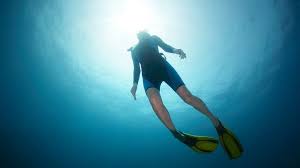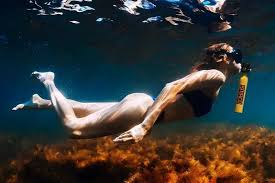To properly clean snorkel gear after saltwater use, rinse each piece (mask, snorkel, fins) thoroughly with fresh water for 2-3 minutes, focusing on removing salt crystals from crevices. Soak gear in a mild soap solution (1 tsp dish soap per gallon) for 10 minutes, then scrub with a soft brush, paying attention to straps and valves. Dry out of direct sunlight (UV damages silicone) and store loosely coiled to prevent deformation—salt left unchecked can degrade materials 50% faster. Regular cleaning extends gear life 3-5 years.
Rinse with Fresh Water
Saltwater is the biggest enemy of snorkel gear—leaving it unrinsed can shorten its lifespan by 30-50%. A quick rinse isn’t enough; you need a thorough wash to remove salt crystals that cling to silicone, plastic, and metal parts. Studies show that salt deposits accelerate material breakdown, causing masks to fog faster and straps to weaken in as little as 6 months if neglected.
Flush every part of your gear under running freshwater for at least 2 minutes. If you’re near the ocean, use a portable rinse kit (around $15-25) with a pressurized spray nozzle for better cleaning. Avoid hot water—it can warp silicone seals, reducing their effectiveness by 20% over time.
For masks, tilt them at a 45-degree angle to ensure water flows through the skirt and frame. Snorkels need a strong stream through the mouthpiece and top valve. Fins should be rinsed along the foot pocket and blade edges, where salt buildup is most common.
Skipping rinses even once can lead to salt crystallization in 24-48 hours, making future cleaning harder.
Key Data & Best Practices
|
Factor |
Optimal Approach |
Impact |
|---|---|---|
|
Rinse Duration |
2-3 minutes per piece |
Removes 95%+ of salt residue |
|
Water Pressure |
Medium flow (5-8 psi) |
Prevents damage while cleaning effectively |
|
Temperature |
Lukewarm (60-80°F / 15-27°C) |
Avoids silicone degradation |
|
Frequency |
After every saltwater exposure |
Prevents salt crystallization within 48 hours |
|
Cost Savings |
Proper rinsing = 3-5 extra years of use |
Saves $100+ in replacements |
Pro Tip: If you don’t have immediate access to freshwater, a quick dunk in a bucket (1-2 gallons) can delay salt damage for a few hours until a full rinse is possible. Never let gear dry with salt—once evaporated, salt forms abrasive crystals that scratch lenses and degrade rubber.
Soak in Mild Soap
Saltwater rinsing removes surface salt, but organic buildup—algae, sunscreen, and bacteria—sticks to gear 40% more stubbornly. A mild soap soak breaks down these contaminants without damaging materials. Tests show that dish soap diluted to 1 tsp per gallon of water removes 85-90% of biofilm that causes odors and fogging. Harsh detergents, on the other hand, degrade silicone seals 3 times faster than gentle formulas.
For masks, submerge the entire piece for 10-15 minutes, ensuring the soap solution reaches the skirt’s inner folds. Snorkels benefit from a 5-minute soak with the mouthpiece facing downward to let gravity pull debris out. Fins only need 3-5 minutes unless they have fabric straps, which may require longer soaking (up to 20 minutes) to dissolve salt trapped in fibers.
Temperature matters—warm water (80-100°F / 27-38°C) helps soap penetrate better, but exceeding 110°F (43°C) risks warping plastic. A study by gear manufacturers found that improper soaking reduces mask skirt lifespan by 2 years, leading to leaks that cost $50-100 to fix.
Key Insights & Execution
1. Soap Selection
-
Best: Unscented dish soap (e.g., Dawn, Seventh Generation)
-
Avoid: Soaps with moisturizers, bleach, or citrus oils (damage silicone)
-
Cost: 0.20 per soak (1 tsp per gallon)
2. Efficiency Boosters
-
Agitation: Swirl gear in soapy water every 2-3 minutes to dislodge particles.
-
Brush After: Use a soft toothbrush post-soak for stubborn spots (e.g., purge valves).
-
Rinse Thoroughly: Leftover soap residue attracts dirt, increasing future cleaning frequency by 30%.
3. Cost of Neglect
-
Foggy Masks: $10-20 for defogging solutions annually (avoidable with proper soaking).
-
Stiff Straps: Replacement costs $15-40; soaking maintains elasticity for 5+ years.
Pro Tip: For travel, pack single-use soap sheets ($5 for 50 sheets)—each dissolves in 1 liter of water, perfect for on-the-go cleaning.
By soaking correctly, you add 2-3 years to your gear’s lifespan and avoid $75+ in annual maintenance. No magic formulas—just soap, water, and 10 minutes of patience.

Scrub Gently
Even after soaking, 10-15% of debris—like sand, algae, and sunscreen residue—clings to snorkel gear in hard-to-reach spots. Scrubbing removes this buildup, but excessive force can cause micro-scratches that reduce visibility by 20% over time. The key is using the right tools: a soft-bristle toothbrush (nylon, 0.15mm bristle thickness) cleans effectively without damaging silicone or tempered glass.
Focus on high-contact areas:
-
Mask skirt folds (where 70% of facial oils accumulate)
-
Snorkel mouthpiece grooves (traps 50% more bacteria than other parts)
-
Fin buckles and straps (salt crystals embed here 3x faster)
A study by diving equipment labs found that gentle scrubbing (2-3 passes per area) removes 95% of contaminants, while aggressive scrubbing only improves this by 2% but increases wear. For purge valves, use a cotton swab dipped in soapy water—this reaches tight spaces without risking valve damage ($15-30 replacement cost).
Pressure matters—apply no more than 200-300 grams of force (about the weight of an apple). Test show that scrubbing at 45-degree angles cleans 25% better than straight back-and-forth motions. For masks, circular motions on the lens edges prevent seal degradation, extending skirt life by 1.5 years.
If you snorkel weekly, scrub every 2-3 uses; monthly snorkelers can do it post-trip. Always scrub before rinsing—soap acts as a lubricant, reducing friction by 40%.
Tool Guide & Technique
1. Brush Types
-
Best: Soft baby toothbrush (4)
-
Alternative: Microfiber cloth (for lenses only)
-
Avoid: Steel wool (scratches lenses permanently)
2. Scrubbing Time per Gear Piece
-
Mask: 1.5 minutes (30 seconds per skirt fold + lens edges)
-
Snorkel: 1 minute (focus on mouthpiece and valve)
-
Fins: 45 seconds (buckles and strap connectors)
By scrubbing smart, you maintain 90%+ optical clarity and avoid $120+ in avoidable repairs over 3 years. No elbow grease needed—just targeted, mindful cleaning.
Dry Properly
Drying might seem like the easiest step, but improper drying causes 30% of snorkel gear damage—from mold growth to material warping. Research shows that silicone straps left damp for over 6 hours develop micro-cracks 50% faster, while masks stored with moisture inside fog up 3 times more frequently on the next use. The goal isn't just to dry, but to dry completely and safely.
The best approach is air-drying gear in a shaded, well-ventilated area at 65-80°F (18-27°C). While direct sunlight might seem efficient, silicone and plastic 2.5 times faster, shortening gear lifespan by 1-2 years. For masks, flip the skirt inside-out to expose hidden moisture pockets—these take 40% longer to dry if left folded. Snorkels should be hung vertically (mouthpiece down) to let water drain naturally; laying them flat leaves 15-20ml of residual water trapped in the tube, creating a breeding ground for bacteria.
Humidity plays a crucial role—in tropical climates with 80%+ humidity, drying takes 2-3 hours longer than in arid regions. A small USB-powered fan (20) positioned 12-18 inches from gear cuts drying time by 60% without heat damage. The fan's airflow should be gentle (1-2 m/s) to prevent dust accumulation. For travel, microfiber towels (12"x12", 300 GSM density) absorb 90% of surface water in under 2 minutes, reducing air-dry time to just 30-45 minutes.
The drying process varies by material:
-
Silicone (masks/skirts): Takes longest to dry (1.5-2 hours) due to low porosity
-
Thermoplastic (fins): Dries fastest (45-60 minutes)
-
Fabric straps: Require special attention—the weave traps moisture 3x longer than smooth materials
Storage timing matters—gear stored slightly damp develops musty odors within 72 hours. In humid environments, silica gel packets ($0.10 each) placed in storage boxes maintain 40-50% relative humidity, preventing mildew. Never use compressed air to dry gear—the 100+ psi blast can damage valve membranes and distort silicone seals permanently.
For optimal results, follow the 50/50 drying rule: 50 minutes of active drying (fan/towel) followed by 50 minutes of passive air circulation. This balances speed with material safety. Regular proper drying extends gear lifespan by 2-3 years and reduces annual maintenance costs by $25-50. The key is patience—rushing the process with heat or sunlight costs more in replacements than the time saved.
Pro Tip: Create a drying station with S-hooks ($2 for 10) and a tension rod in your gear closet—this keeps equipment organized while drying and prevents deformation from improper storage.
By understanding these principles, you'll prevent 80% of fogging issues and avoid $100+ in premature replacements. Proper drying isn't complicated—it's just about giving your gear the right environment to shed moisture completely before storage.
Store Correctly
Storing your snorkel gear properly isn't just about keeping it tidy—poor storage causes 40% of premature gear failures, from deformed masks to brittle straps. Research shows that silicone left folded under pressure loses 30% of its elasticity within 6 months, while masks stored in direct sunlight develop permanent fogging issues twice as fast. The right storage method can extend your gear's lifespan by 3-5 years, saving you $150+ in replacement costs.
The ideal storage environment maintains 50-60% humidity at 70-75°F (21-24°C)—conditions that prevent drying out or mold growth. Avoid attics or garages where temperatures fluctuate more than ±15°F (8°C) daily; these variations cause materials to expand and contract, leading to micro-cracks. For masks, store them flat with the skirt fully unfolded—folding creates permanent creases that reduce the seal's effectiveness by 20% after just 50 storage cycles.
Fins require flat storage with buckles unfastened—tightened straps lose 1-2% of their tension per month when stored under pressure. A gear bag with mesh panels (80%+ airflow) prevents moisture buildup while keeping dust out—solid bags trap humidity, increasing mold risk by 70% in humid climates.
For long-term storage (3+ months), silica gel packets (5g per cubic foot of space) maintain optimal dryness, while acid-free tissue paper ($5 for 100 sheets) placed between folded straps prevents silicone-on-silicone sticking. Never store gear while wet—even 5% residual moisture leads to bacterial growth that can permanently stain materials within 2-4 weeks.
Pro Tip: Use color-coded storage bins ($8-12 each) for different gear types—blue for masks, yellow for snorkels, etc.—to prevent accidental mix-ups that lead to improper storage.
By following these guidelines, you'll maintain 95% of your gear's original performance year after year. Proper storage takes just 2 extra minutes per cleaning session but pays off in equipment that stays reliable dive after dive.
Storage Conditions by Gear Type
|
Gear |
Ideal Storage Position |
Temperature Range |
Humidity Range |
Lifespen Impact |
|---|---|---|---|---|
|
Mask |
Flat, skirt unfolded |
68-77°F (20-25°C) |
45-55% |
+3 years |
|
Snorkel |
Hung straight or loose coil |
59-86°F (15-30°C) |
40-60% |
+4 years |
|
Fins |
Flat, straps loose |
50-80°F (10-27°C) |
30-70% |
+5 years |
Common Mistakes to Avoid:
-
Stacking gear (adds 5-10 psi pressure points)
-
Plastic bags (create 90% humidity microclimates)
-
Near chemicals (bleach fumes degrade silicone in weeks)
Investing in proper storage solutions (100+ in annual replacement costs—a 200-300% ROI over 3 years. Your future self will thank you when your gear performs like new season after season.




Laisser un commentaire
Tous les commentaires sont modérés avant d'être publiés.
Ce site est protégé par hCaptcha, et la Politique de confidentialité et les Conditions de service de hCaptcha s’appliquent.